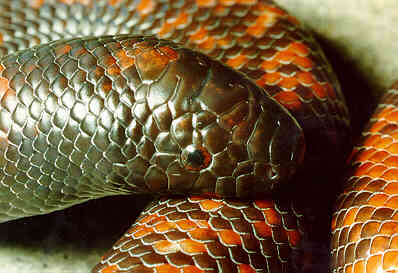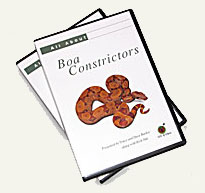Calabar boas...
Dear VPI,
I just bought a Calabar burrowing python at a pet shop. The owner told me that he didn't know whether or not it was captive-bred. He said it was feeding on newts at the store. Can you give me any information on my snakes? Thanks, Will
Dear Will,
Calabaria is no longer classified as a python. There's some controversy as to whether it is an erycine snake (related to sandboas) or it belongs in its own subfamily in the Boidae, but it's not a python. The accepted common name these days is the "Calabar boa."
Most newts have toxic substances in the skin and  Calabar boaCalabaria will die if they consume them. Personally I strongly doubt that Calabaria will eat newts-nothing like a newt or a salamander of any sort is found in their range in Africa. But even if they will eat them, they shouldn't be given the opportunity.
Calabar boaCalabaria will die if they consume them. Personally I strongly doubt that Calabaria will eat newts-nothing like a newt or a salamander of any sort is found in their range in Africa. But even if they will eat them, they shouldn't be given the opportunity.
In the wild and in captivity, Calabaria are predominantly rodent eaters. We find that most readily accept appropriate-sized mice or rats.
We keep them in a cage on aspen bedding and we find them to be very hardy. They do burrow in the aspen, but most of the time they sit on top in plain sight. They need some humidity, but they do not tolerate wet or damp conditions.
However, Calabaria need fresh water. It's far more important to them than to most snakes in captivity. They will die of thirst if they don't have water to drink for a day or two. Other erycine snake are more tolerant of the water bowl drying out-some don't need to drink for weeks or longer.
Captive-bred specimens are very rare, as the species is rarely bred in captivity. It's unlikely that a pet store had a captive-bred specimen to sell.
They are a cool species that would benefit from more attention from keepers, good luck with them. DGB
